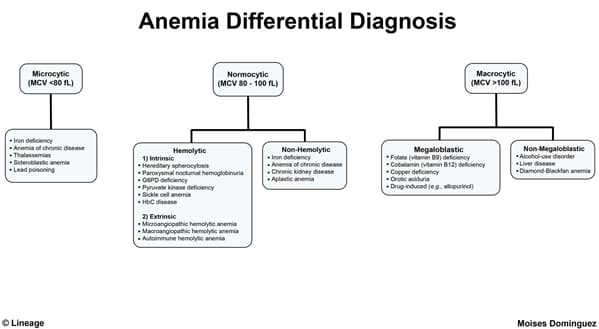Snapshot
- A 2-year-old girl is teething and chewing on objects found in the home. The parents state that for the past few days, their daughter has been fussy and at times appears lethargic and pale. They also noticed that she has been clutching her abdomen in pain and refusing to eat even her favorite foods. Laboratory testing reveals an elevated free erythrocyte protoporphyrin (FEP) level, along with the finding on peripheral blood smear seen in the image.
Introduction

- Overview
- lead poisoning is caused by occupational and environmental lead exposure and can cause damage to various body systems
- treatment may involve chelation therapy
- lead poisoning is caused by occupational and environmental lead exposure and can cause damage to various body systems
- Epidemiology
- prevalence
- estimated 1.2 million children in the US
- estimated 16 per 100,000 employed adults (due to occupational exposure)
- demographics
- children aged 1-5 years
- children < 3 years at greatest risk
- most likely to put items containing lead into their mouths
- children < 3 years at greatest risk
- adults with occupational exposure to lead or exposure through a hobby
- children aged 1-5 years
- location
- absorption through respiratory tract, GI tract, and skin
- distribution to blood, soft tissues, and bones
- risk factors
- age
- infants and young children more likely to chew paint flaking off walls or consume lead dust from their contaminated hands
- living in a house built before 1978 with chipped paint
- occupational exposure in lead-related industries (i.e., battery recycling, manufacturing, construction, and mining)
- exposure from hobbies involving lead (i.e., car repair, metal soldering, and glazed pottery making)
- age
- prevalence
- Pathophysiology
- lead causes toxicity through the generation of reactive oxygen species
Presentation
- Symptoms
- typically nonspecific, result from lead toxicity
- irritability
- headache
- hyperactivity or lethargy
- anorexia
- various body systems affected
- hematological
- anemia
- gastrointestinal
- intermittent abdominal pain
- constipation
- vomiting
- renal
- interstitial nephritis
- CNS
- memory loss
- confusion
- encephalopathy
- hematological
- typically nonspecific, result from lead toxicity
- Physical exam
- peripheral neuropathy
- wrist or foot drop
- peripheral neuropathy
- pallor
Imaging
- Radiographs
- indications
- abdominal x-ray in all children with suspected ↑ blood lead levels
- indications
- rarely seen except in cases of severe lead toxicity
Studies
- Serum labs
- blood lead level
- most accurate test for lead poisoning
- ↑ lead level (> 10 μg/dL) on venous blood sample
- free erythrocyte protoporphyrin (FEP) level
- ↑ FEP due to inhibition of enzymes involved in hemoglobin synthesis
- note, iron deficiency anemia may also produce an ↑ in FEP
- ↑ serum iron and ferritin
- blood lead level
- Histology
- peripheral blood smear
- hypochromic microcytic anemia
- peripheral blood smear
- basophilic stippling of RBCs
Differential Diagnosis
Treatment
- Lifestyle
- prevent further exposure to lead via assessment of environmental and occupational exposure
- modify children’s behavior to decrease hand-to-mouth activity
- Medical
- crosses blood brain barrier
Complications
- Developmental delay in children
- Lead encephalopathy
- treatment
- chelation therapy
- treatment



